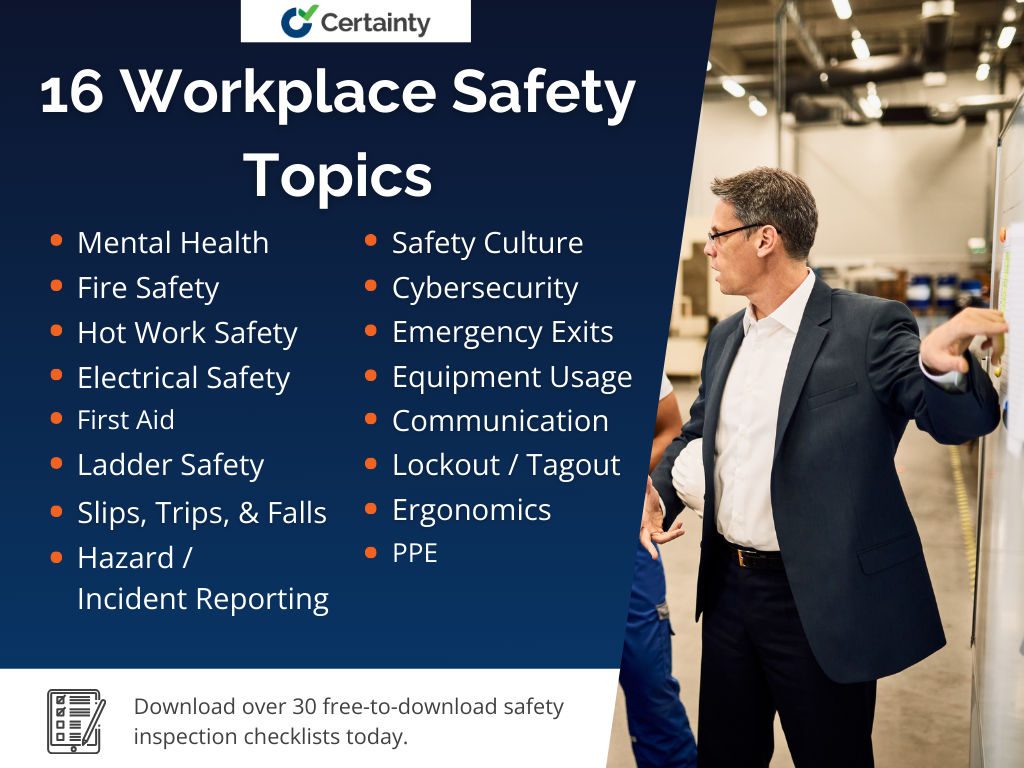Table of contents

As a safety leader, it is crucial to prioritize addressing the most pressing safety issues in your safety meetings. Ensuring the health and safety of your team members and employees should be your top priority, while also implementing proactive strategies to minimize workplace accidents and injuries.
But what are the foundational topics that businesses can rely on to initiate effective safety meetings? Let’s first clarify what a safety meeting is.
What is a Safety Meeting?
Sometimes referred to as a safety brief, a safety meeting is a regularly scheduled gathering of employees and safety managers to discuss workplace safety topics and concerns.
Safety meetings provide several benefits, including teaching employees about the newest safety practices and technology, updating them on changes in legislation and standards, and getting their input and recommendations. Usually, they take place once a week or once a month, depending on the organization’s size and makeup.
Remember, toolbox talks and safety meetings are not the same. Safety meetings are more formal and usually cover a wider variety of safety themes than quick toolbox talks informal safety presentations that happen at the job site and concentrate on a particular safety topic.
How to Make Your Safety Meetings More Engaging
Use evidence
It is crucial to have evidence to back up the discussions held during safety meetings. This can be achieved by referring to reliable sources such as checklists, like Certainty’s Facility Safety Inspection Checklist or Lifting and Lowering Ergonomic Assessment Checklist, which can provide evidence-based information to support the discussions.
Encourage participation
To make safety meetings effective, it is essential to engage your team in the discussions. Encourage them to participate and share their thoughts and experiences. You can do this by asking for feedback and suggestions for improvements, conducting interactive activities such as quizzes, and recognizing their contributions. OSHA’s Workplace Safety and Health Quiz is an easy and effective way of developing your safety meeting quizzes for your next workplace safety meeting.
Change up the topics
To keep the discussions interesting and engaging, it is important to vary the topics covered during safety meetings. Focus on the most critical issues and include new and relevant topics such as mental health, cyber security, workplace violence, safeguarding, and worksite communication.
Use visual aids
Visual aids such as slides, videos, or posters can help to make the discussions more engaging and memorable. They can also help to demonstrate the importance of certain safety practices and procedures. To help you build visual aids, here’s a safety training example presentation from the Institute of Occupational Health and Safety (IOSH).
Follow up
After each safety meeting, it is important to follow up on the discussions and actions taken. This can be done by sending out meeting minutes, keeping track of any new hazards or incidents that arise, and regularly reviewing the effectiveness of the safety measures and procedures.
16 Safety Talk Topics
In the end, your corporate safety culture and goals will determine the subjects you choose to cover in your safety meetings. Below, we’ve highlighted 16 essential topics to cover in your meetings—each designed to promote a culture of safety and proactive risk management.

Mental Health
An essential aspect of overall health and well-being, employee mental health is crucial to address in the workplace. Discussions on managing stress and avoiding burnout can help employees maintain their mental health and improve their productivity. Studies have shown that depression can reduce cognitive performance about 35% of the time. If your workplace offers a mental health program or other forms of support, be sure to remind employees of the resources available.
Fire Safety
According to OSHA, in the construction industry alone there is an average of 36 fire-related deaths per year. There are numerous options to pick from when discussing fire safety at the workplace. For instance, you could opt for one meeting to be a reminder of where fire extinguishers are located and how to properly use them. Or, you might want to go over the fire emergency evacuation routes and muster point locations in another.
Hot Work Safety
There are several approaches you might use when discussing this issue in a safety meeting. All seek to stop major injuries caused by hot labor activities, like welding, for example. Some of those steps you can take include using appropriate personal protective equipment (PPE), adhering to electrical safety regulations, conducting gas testing, isolating flammable sources, constructing a welding booth, and taking the proper precautions and control measures for hot work.
Electrical Safety
In the workplace, this subject is crucial for preventing electrocution, fires, and equipment damage. You can cover the risks associated with working with electricity, including moist circumstances, malfunctioning outlets, exposed wires, and overloaded circuits. Additionally, you should offer advice on how to prevent these risks, such as using insulated tools, using safety goggles, disconnecting equipment before doing maintenance, and adhering to lockout/tagout protocols.
First Aid
While a full first aid discussion is likely too long for a safety meeting, it’s still an opportunity to refresh your memory and go over the key elements of first aid safety in your meeting. The meeting can be simply about where first aid kits are located, or a reminder of first aid techniques such as CPR.
Ladder Safety
No this isn’t just a quick discussion on the traditional maintaining three points of contact procedures. While still vital to the collective goal of ladder safety, there’s more that can be discussed at these safety meetings. According to the U.S. Bureau of Labor Statistics, there were 161 fatal ladder-related workplace fatalities in 2020. This safety meeting can go into much deeper discussion such as how to perform a pre-use ladder inspection, signs of defective ladders, the proper operation and placement of ladders, and knowing when perhaps a scissor jack is more optimal than a ladder.
Personal Protective Equipment (PPE)
PPE is a crucial aspect of workplace safety and protects employees from hazards in the workplace. Focusing on this topic during safety meetings can be short training on properly wearing hard hats, respirators, hearing protection, and other PPE. Or, you could discuss how to identify signs of PPE defects. It’s also an opportunity for employees to self-police their own PPE rather than wait for a full-scale PPE inspection.
Hazard and Incident Reporting
The Occupational Safety and Health Administration (OSHA) requires employers to report any workplace incidents. During a safety meeting focused on this topic, you can discuss the procedures for reporting hazards and incidents, and the importance of safety reporting them to ensure the safety of all employees.
Safety Culture
Equally as important as any other safety meeting topic, don’t hesitate to dedicate a safety meeting to emphasizing what your safety culture is. Using this meeting topic brings everything together to communicate what the company stands for in terms of safety. In a more motivational sense, it can highlight that safety is a collective effort and that everyone is working together to ensure everyone gets home safely.
Cybersecurity
In today’s digital age, cybersecurity is a crucial aspect of workplace safety. In 2022 alone, 1,802 US businesses experienced data compromises affecting over 420 million individuals. Take this opportunity to collaborate and teach on ways to prevent phishing or hacking with workplace technology. Doing so will help protect the company’s sensitive information and prevent catastrophic data breaches.
Emergency Exits
Take the opportunity in your safety meeting to focus on your safety exits. Whether it be their locations, the importance of maintaining clear exit routes, or where to find posted evacuation plans, it’s all about making sure your staff knows the quickest and safest way out in an emergency.
Proper Use of Equipment
Whether it be heavy machinery, tools, or vehicles, prevent complacency and ultimately worker or equipment damage with reminders on any signs of equipment defects, the proper techniques for using the equipment, and the procedure for proper equipment shutoff and storage.
Communication
Here you have the opportunity to emphasize open hazard communication in your team. This could relate to safety concerns, questions, or incident recognition. Whatever it may be, it’s important to remind your staff who to speak with, and that hazard communication lines are always open.
Lockout and Tagout
Both lockout and tagout procedures are essential for controlling hazardous energy sources. During this meeting, you can discuss the importance of following these procedures to prevent accidents and injuries.
Ergonomics
Proper ergonomics can help prevent musculoskeletal disorders and other injuries. In a meeting regarding this topic, key discussion points revolve around proper lifting techniques and the proper use of lifting aids and equipment. To make the meeting more engaging, you can use videos or posters to enhance the takeaways.
Slips, Trips, and Falls
Slips, trips, and falls are some of the most common causes of workplace injuries – with the U.S. Department of Labor reporting 211,640 reported slips, trips, and fall incidents in 2020. In a meeting focused on this topic, provide reminders of what leads to preventable slips, trips, or falls such as cluttered walking paths, unattended spills, and unsecured cords or cables. Ultimately, this should lead to fewer near misses.

30+ Audit and inspection checklists free for download.
Book a demo today to discover how Certainty supports safety audits and inspections.
FAQ
What is a safety meeting?
A safety meeting is a regularly scheduled gathering of employees and safety managers to discuss workplace safety topics and concerns.
Are safety meetings and Toolbox Talks the same?
No, toolbox talks and safety meetings are not the same. Safety meetings are more formal and usually cover a wider variety of safety themes than quick toolbox talks informal safety presentations that happen at the job site and concentrate on a particular safety topic.
What are some safety meeting topics?
- Mental health
- Fire safety
- Hot work safety
- Electrical safety
- First aid
- Ladder safety
- Personal Protection Equipment (PPE)
- Reporting of hazards and incidents
- Safety culture
- Cyber security
- Emergency exits
- Proper use of equipment
- Communication
- Lockout and Tagout
- Ergonomics
- Slips, Trips, and Falls
What are 5 ways to make safety meetings more engaging?
- Use evidence such as data from internal safety audits and inspections
- Encourage participation and open discussion
- Change the topic of discussion regularly
- Use visual aids such as infographics, slides, videos
- Follow up often to ensure safety meetings are effective



